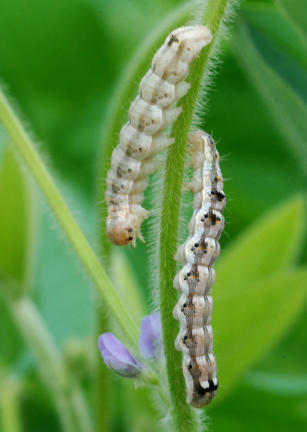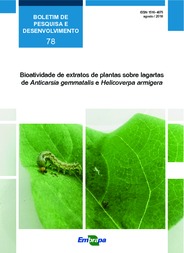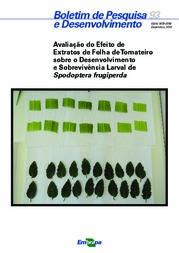Plant extracts are efficient to control caterpillars
Plant extracts are efficient to control caterpillars
Photo: Jeanne Marinho-Prado

The Anticarsia gemmatalis caterpillar suffered the highest effect from natural extracts
Studies conducted by researchers from Embrapa Environment assessed the bioactivity of four plant extracts against the caterpillars Helicoverpa armigera and Anticarsia gemmatalis, two important agricultural pests. The scientists discovered that the extracts of the plant species Clerodendrum splendens, Conyza canadensis, Tithonia diversifolia and Vernonanthura westiniana produce effects that have the potential to control the insects, such as weight reduction or reducing leaf consumption - and, in A.gemmatalis' case, insecticidal effects with up to 80% mortality were found. The results open opportunities for the development of natural products to be used in organic cultivation, or even for the use of such plants in the synthesis of new insecticide compounds.
The scientists evaluated each plant diluted in four different solvents (water, dichloromethane - DCM, hexane and methanol) and had evidence that the extracts of all the plant species assessed caused a reduction in the caterpillars' weight. This occurred in at least one of the solvents. With the exception of T. diversifolia, all plant species also caused the reduction in the leaf consumption of caterpillars in some of the solvents evaluated.
"The goal was to assess whether the extracts made with each of the four plant species presented insecticidal or harmful effect on the development of the H. armigera and A. gemmatalis caterpillars through their ingestion,” reports the Embrapa researcher Jeanne Prado, one of the authors of the study.
The intricate relationship between insects and plantsThe researcher Jeanne Prado explains that the relationship between insects and plants is regulated by substances called allelochemicals that, once they are released by the plants, are perceived by the insects and can stimulate their behavior or change characteristics of their cycle. If the stimulaton provided by the plant is positive, the insects will be drawn to it (attractive substance); if it is negative, they will go to the opposite direction (repellent substance). After contact with the plant, another positive stimulus will lead to a bite or to a test bite (inciting substance) or, in the case of a negative stimulus, the insects will not prove the plant and they will move away (suppressive substance). Finally, after tasting it, the insects can receive stimulation to keep feeding (phagostimulant) or to stop feeding from it (phagoinhibitant). |
Currently, caterpillars are controlled through the use of agrochemicals and genetically modified plants with Cry1Ac, a protein from Bacillus thuringiensis that has a toxic effect on the insect. However, the increase in the number of individuals that are resistant to such molecules used in the market and the rise of hybrid insects (deriving from the crossing between Helicoverpa armigera and H. zea) has reduced the effectiveness of these approaches and stimulated the search for new products to control such pests.
A. gemmatalis caterpillars consumed a greater leaf area containing methanolic extracts of C. canadensis and T. diversifolia than the leaves that only contained water (within the analyses of each plant species), suggesting that there can be, in these extracts, substances working as phagostimulants (see box on the right) for such insects.
However, the high consumption of a plant does not always represent advantages to the insects, once the leaves can have other substances with antibiotic effects, which cause mortality or reduction in size, weight, longevity and fertility. A similar situation occurred when H. armigera caterpillars fed from leaves containing the methanolic extract from V. westiniana. The extract did not change the caterpillars' appetite in the first 24 hours and even increased leaf consumption after 48 hours of the assessment. However, it reduced the weight of pupas, indicating an antibiosis effect.
Insecticidal extracts
Two extracts stood out due to their insecticidal potential against A. gemmatalis. C. splendens', in DCM or hexane, caused mortality above 60% in caterpillars, on top of reducing larvae and pupas' weight gain. The methanolic extract of V. westiniana, in turn, caused mortality above 80% in the population of A. gemmatalis caterpillars and it was thus selected for assessment on H. armigera caterpillars. “We used this procedure due the difficulties in multiplying the H. armigera species in enough amounts to conduct all the bioassays for the assessment of compounds", Jeanne Prado explains.
However, despite the high mortality caused in A. gemmatalis caterpillars, the same V. westiniana methanolic extract caused a mortality of only 20% of the assessed population of H. armigera.
Helicoverpa armigera is next target
The targetsKnown as the velvetbean caterpillar, A. gemmatalis is considered the main pest for soybeans, as it is an important defoliant insect in Brazilian soybean farming. The species H. armigera has a large dispersion capacity. At its larval stage it can feed from more than 60 plant families, and today it can be foung in the entire domestic territory, especially attacking maize, beans and cotton as well as soybeans. |
The resistance of H. armigera populations to insecticidal molecules is the target of different studies and has been associated with the characteristics that are intrinsic to the species, such as: highly polyphagous food habits, short cycle of development, high capacity for dispersion and high genetic variability. Therefore, there should be new bioassays with H. armigera using the plant extracts that were only assessed for A. gemmatalis, considering the differences in their interespecific relationships and response to plant defense.
The following stages are also going to include the identification of molecules responsible for antibiosis or antixenosis action observed in the extracts, their action mechanism and assessing whether such molecules are capable of affecting non-target organisms like other insects, for instance.
The scientists hope that this work generates alternative products to be employed in the integrated management of such pests (IPM) in the fields.
Part of the information from this study conducted by the researchers Jeanne Marinho-Prado, Sonia Queiroz, Simone Prado and Marta Assis are in a research bulleting available online.
Cristina Tordin (MTb 28.499/SP)
Embrapa Environment
Press inquiries
meio-ambiente.imprensa@embrapa.br
Phone number: +55 19 3311-2608
Translation: Mariana Medeiros (13044/DF)
General Secretariat
Further information on the topic
Citizen Attention Service (SAC)
www.embrapa.br/contact-us/sac/




